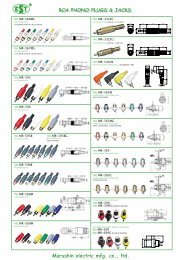Preferential Adsorption and Co-nonsolvency of ... - au one net
Preferential Adsorption and Co-nonsolvency of ... - au one net
Preferential Adsorption and Co-nonsolvency of ... - au one net
Create successful ePaper yourself
Turn your PDF publications into a flip-book with our unique Google optimized e-Paper software.
Macromolecules ARTICLE<br />
Figure 1. Model solution <strong>of</strong> hydrogen-bonded polymers in a mixed<br />
solvent. Both solvents A <strong>and</strong> B are assumed to be capable <strong>of</strong> forming<br />
hydrogen bonds with the polymers, so that there is a competition in<br />
forming p-A <strong>and</strong> p-B hydrogen bonds.<br />
nA for A <strong>and</strong> nB for B in the unit <strong>of</strong> the cell volume. We assume<br />
incompressibility <strong>of</strong> the solution, so that we have Ω = nN þ<br />
n AN A þ n BN B,whereΩ V/a 3 is the total number <strong>of</strong> cells.<br />
To describe the H-bonds <strong>of</strong> A <strong>and</strong> B with the polymer chains,<br />
let (l, m) be the type <strong>of</strong> the polymer chains which carry the<br />
number l <strong>of</strong> bound A molecules <strong>and</strong> m <strong>of</strong> bound B molecules <strong>and</strong><br />
let Nl,m be the number <strong>of</strong> polymers <strong>of</strong> the type (l, m) in the<br />
solution. The total number <strong>of</strong> A molecules on a chain is ∑lNl,m,<br />
<strong>and</strong> B molecules is ∑mNl,m. Let NfA be the number <strong>of</strong> free A<br />
molecules, <strong>and</strong> let N fB be that <strong>of</strong> free B molecules.<br />
We then have the material conservation laws<br />
<strong>and</strong><br />
N ¼ X<br />
Nl, m<br />
l, m<br />
NA ¼ NfA þ X<br />
NB ¼ NfB þ X<br />
lNl, m<br />
l, m<br />
mNl, m<br />
l, m<br />
Ω ¼ X<br />
ðn þ nAl þ nBmÞNl, m þ nANfA þ nBNfB<br />
l, m<br />
The free energy we consider is<br />
βΔF ¼ X<br />
Nl, m ln φl, mþNfA ln φfA þ NfB ln φfB l, m<br />
ð2.1aÞ<br />
ð2.1bÞ<br />
ð2.1cÞ<br />
ð2.2Þ<br />
þ X<br />
Δl, mNl, m þ ΩgðfφgÞ ð2.3Þ<br />
l, m<br />
where β 1/kBT, <strong>and</strong><br />
φl, m ðnþnAl þ nBmÞNl, m=Ω ð2.4Þ<br />
is the volume fraction <strong>of</strong> the (l, m) polymers, <strong>and</strong><br />
φf R nRNfa=Ω ðR ¼ A, BÞ ð2.5Þ<br />
are the volume fractions <strong>of</strong> the free solvent molecules. The<br />
number density <strong>of</strong> the complex molecules <strong>of</strong> the type (l, m) is<br />
νl, m ¼ Nl, m=Ω ð2.6Þ<br />
The free energy<br />
Δl, m βΔAl, m ð2.7Þ<br />
for the formation <strong>of</strong> a complex <strong>of</strong> the type (l, m) depends on the<br />
details <strong>of</strong> the H-bonds, which will be specified when we calculate<br />
the solution properties.<br />
The molecular interaction is included in the last term <strong>of</strong> eq 2.3<br />
in the form<br />
gðfφgÞ ðχAφA þ χBφBÞφ þ χABφAφB ð2.8Þ<br />
where χA, χB, <strong>and</strong> χAB are Flory’s interaction parameters between<br />
polymer <strong>and</strong> A-solvent (p/A), polymer <strong>and</strong> B-solvent (p/B), <strong>and</strong><br />
A-solvent <strong>and</strong> B-solvent (A/B). They are based on the van der<br />
Waals interaction in the background <strong>and</strong> functions <strong>of</strong> the temperature<br />
only. (We do not assume ternary interaction term χTφφAφB in<br />
the free energy bec<strong>au</strong>se its molecular origin is not clear.)<br />
By differentiation with respect to Nl,m, NfA, <strong>and</strong> NfB, wefind<br />
the chemical potentials<br />
βΔμl, m<br />
n þ nAl þ nBm ¼ 1 þ Δl, m þ ln φl, m<br />
n þ nAl þ nBm - νS þ gl, m ð2.9Þ<br />
for the polymer <strong>of</strong> (l, m) type, <strong>and</strong><br />
βΔμfA =nA ¼ð1þln φfAÞ=nA - ν S þ gfA ð2.10aÞ<br />
βΔμ fB =nB ¼ð1 þ ln φ fBÞ=nB - ν S þ gfB<br />
for the free solvent molecules, where<br />
v S<br />
X<br />
vl, mþ φfA þ<br />
nA<br />
φfB nB<br />
l, m<br />
ð2.10bÞ<br />
ð2.11Þ<br />
is the total number <strong>of</strong> translational degree <strong>of</strong> freedom in the<br />
solution, <strong>and</strong><br />
gfA - g þ χAφ þ χABφB ð2.12aÞ<br />
gfB - g þ χ B φ þ χ AB φ A ð2.12bÞ<br />
have appeared from the interaction terms. Also, we have<br />
gl, m<br />
ng0, 0 þ nAlgfA þ nBmgfB<br />
n þ nAl þ nBm<br />
ð2.13Þ<br />
for the (l, m) complexes, where<br />
g0, 0 - g þ χAφA þ χBφB ð2.14Þ<br />
By imposing the association equilibrium conditions<br />
Δμl, m ¼ Δμ0, 0 þ lΔμfA þ mΔμfB ð2.15Þ<br />
we find<br />
l m<br />
φl, m ¼ Kl, mφ0, 0φfA φfB ð2.16Þ<br />
where<br />
Kl, m ¼ expðl þ m - Δl, mÞ ð2.17Þ<br />
is the equilibrium constant. Let us write as x φ0,0 <strong>and</strong> yR φfR (R = A, B) for the bare polymer chains <strong>and</strong> the free solvent<br />
molecules. We then have<br />
φ ¼ nxpðyA, yBÞ ð2.18aÞ<br />
φA ¼ yA þ nAφθAðyA, yBÞ ð2.18bÞ<br />
φB ¼ yB þ nBφθBðyA, yBÞ ð2.18cÞ<br />
by the material conservation laws (2.1a) to (2.1c), where the<br />
function p(yA,yB) isdefined by<br />
pðyA, yBÞ<br />
X<br />
bl, my l AymB ð2.19Þ<br />
2980 dx.doi.org/10.1021/ma102695n |Macromolecules 2011, 44, 2978–2989<br />
l, m












